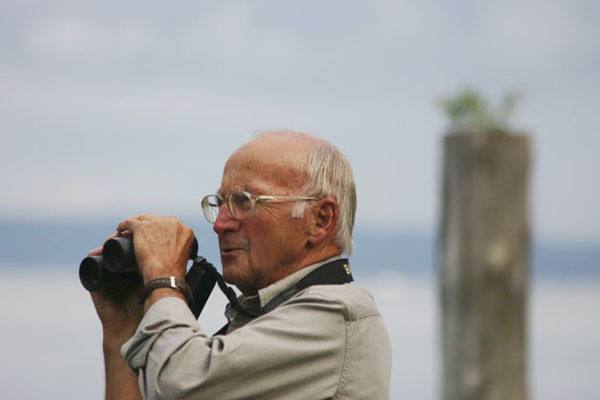Every rescue tale has a hero, and the large, dark swallows called purple martins have a cadre of volunteer heroes who have revived the bird species in the Northwest. Vashon’s local purple martin hero is Islander Rich Siegrist, who for 17 years has volunteered as “landlord” of the martins’ nesting boxes and gourds that hang on the dock pilings that circle Vashon and Maury.
These nesting sites are the primary engine of the recovery. Seagrist said he was driven to help the species because of his fascination with the bird, “especially the martins’ desire to nest over the water.”
“I spotted them (in 1993) down by Cove, so I thought we could provide them better housing,” he added.
Indeed, the “better housing” prompted significantly more martins to nest around the Island and committed Siegrist to give over a portion of his life to these birds, building, hanging and keeping data on a total of 80-plus nesting boxes.
Attracted by Siegrist’s boxes and gourds, Vashon’s martin population has risen steadily on the average. His data show that the highest years were 2004, when 72 nested in the boxes plus two pairs nested in the pilings, for 74 total. In 2005, 72 pairs nested in the boxes plus four pairs nested in the pilings for 76 total. Some years, the numbers drop to the low 30s, most likely due to late springs and cool summers when the insects, the martins’ main food, fail to hatch and fly, ornithologists believe.
Siegrist will present his story and nesting data as part of a panel on purple martins and their recovery on Vashon, which will be held on Thursday, Sept. 15. (See box.)
Western purple martins are Western Washington’s largest swallows, slightly smaller than robins. They are blackish purple. The male is dark bellied, unlike the lighter coloring of the other local swallows. The female’s underside is grey. When soaring for insects, usually above an open space or wetland, martins fly higher than other swallow species. Their call is a liquid gurgle ending with guttural notes. Purple martins are a candidate for listing as a state-threatened or endangered species.
In the past 200 years, the martin numbers have had lows and highs in Puget Sound. “Birds of Washington State,” a reference detailing the state’s 483 bird species, outlines the martins’ local history. In the late 1700s into the 1800s, martins are seldom, if at all, mentioned in bird lists compiled by pioneering naturalists. A few martins were noted in natural nesting sites such as tree snags. However, after American settlement in the early 1900s, martin numbers increased dramatically. By the 1940s, their numbers rose to 7,000 to 12,500 in Seattle alone.
The population increase is attributed to changes in landscape and in building practices. As the forests were logged, breeding pairs found foraging sites in the newly opened meadows and wetlands as flying insects proliferated in those ecosystems. Fish-processing and lumber wharves provided new nest sites in the structures’ wooden posts and planks. Dock pilings filled river banks and shorelines and were subsequently abandoned, opening nest sites, as the oyster, salmon, and lumber industries boomed and imploded. To this day, these pilings, being over water, provide sites, protected from predators such as raccoons and foxes. Even derelict wooden sailing ships, abandoned by the hundreds after steam power replaced wind power, made suitable nest sites. Other manmade structures supplied crevices or rot pockets for nesting.
In the 1970s, the martins’ numbers shifted again, plummeting dramatically. Seattle’s 7,000 to 12,500 martins counted in the 1940s were reduced to the “last nesting pair” observed at Seattle’s downtown Bon Marche (now Macy’s) parking garage. However, natural nesters (i.e. in snags and other tree holes) continued to migrate back each spring in small numbers. Natural areas on Fort Lewis retained a remnant population.
References list the causes of decline as lack of nesting sites (building construction was tighter), spraying or filling of insect-producing wetlands, removing snags as part of clear cutting forests and the arrival of so-called nest usurpers, such as the European starling and the house sparrow.
Then in the mid 1990s, heroes such as Siegrist emerged to provide housing for martin nests and facilitate their recovery. From the Columbia River to British Columbia, the majority of nests have human landlords. The late Kevin Li, a state fisheries biologist, led this wider recovery, involving volunteers from Lower Columbia River, Puget Sound, Hood Canal and British Columbia. By 2005, the estimated state population increased to 600 nesting pairs, mostly in human-tended nest sites.
In 2006, the state’s efforts to clean up Puget Sound included removal of creosote pilings, the martin’s primary nesting sites. In 2007, members of Vashon Audubon met with state workers, asking that Vashon’s Mosquito Fleet and other relic pilings not be removed. Audubon argued that the pilings had ecological value as martin nest sites that outweighed the threat of creosote contamination, its toxins possibly reduced by the pilings’ weathering.
The state modified the piling-removal proposal for Vashon and Maury when Siegrist stepped forward with his binders full of data that outline the successful recovery of Vashon’s purple martins.
— Ann Spiers is a Vashon poet and naturalist.
Rich Siegrist will present his story and nesting data as part of a panel discussion, “Purple Martin’s Amazing Recovery: A Vashon Island Tale of Success.” Joining him will be local naturalist Ann Spiers and master birder Alan Huggins. Sponsored by the Vashon Audubon Society, the program is free and open to the public. It will be held at the Land Trust Building at 7 p.m. Thursday, Sept. 15.



